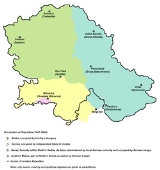
Occupation of Vojvodina, 1941-1944
Encyclopedia
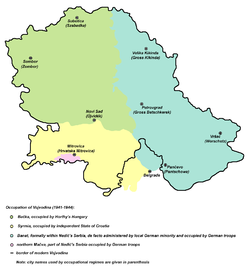
Vojvodina
Vojvodina, officially called Autonomous Province of Vojvodina is an autonomous province of Serbia. Its capital and largest city is Novi Sad...
(a province of modern Serbia
Serbia
Serbia , officially the Republic of Serbia , is a landlocked country located at the crossroads of Central and Southeast Europe, covering the southern part of the Carpathian basin and the central part of the Balkans...
) from 1941 to 1944 was carried out by Nazi Germany
Nazi Germany
Nazi Germany , also known as the Third Reich , but officially called German Reich from 1933 to 1943 and Greater German Reich from 26 June 1943 onward, is the name commonly used to refer to the state of Germany from 1933 to 1945, when it was a totalitarian dictatorship ruled by...
and its client states / puppet regimes: Horthy's
Miklós Horthy
Miklós Horthy de Nagybánya was the Regent of the Kingdom of Hungary during the interwar years and throughout most of World War II, serving from 1 March 1920 to 15 October 1944. Horthy was styled "His Serene Highness the Regent of the Kingdom of Hungary" .Admiral Horthy was an officer of the...
Hungary
Hungary during World War II
Hungary during World War II was a member of the Axis powers. In the 1930s, the Kingdom of Hungary relied on increased trade with Fascist Italy and Nazi Germany to pull itself out of the Great Depression. By 1938, Hungarian politics and foreign policy had become increasingly pro-Fascist Italian and...
and Independent State of Croatia
Independent State of Croatia
The Independent State of Croatia was a World War II puppet state of Nazi Germany, established on a part of Axis-occupied Yugoslavia. The NDH was founded on 10 April 1941, after the invasion of Yugoslavia by the Axis powers. All of Bosnia and Herzegovina was annexed to NDH, together with some parts...
.
In 1941, during World War II
World War II
World War II, or the Second World War , was a global conflict lasting from 1939 to 1945, involving most of the world's nations—including all of the great powers—eventually forming two opposing military alliances: the Allies and the Axis...
, Nazi Germany
Nazi Germany
Nazi Germany , also known as the Third Reich , but officially called German Reich from 1933 to 1943 and Greater German Reich from 26 June 1943 onward, is the name commonly used to refer to the state of Germany from 1933 to 1945, when it was a totalitarian dictatorship ruled by...
, Fascist Italy
Kingdom of Italy (1861–1946)
The Kingdom of Italy was a state forged in 1861 by the unification of Italy under the influence of the Kingdom of Sardinia, which was its legal predecessor state...
and Hungary
Hungary
Hungary , officially the Republic of Hungary , is a landlocked country in Central Europe. It is situated in the Carpathian Basin and is bordered by Slovakia to the north, Ukraine and Romania to the east, Serbia and Croatia to the south, Slovenia to the southwest and Austria to the west. The...
invaded and occupied the Kingdom of Yugoslavia
Kingdom of Yugoslavia
The Kingdom of Yugoslavia was a state stretching from the Western Balkans to Central Europe which existed during the often-tumultuous interwar era of 1918–1941...
. The Vojvodina
Vojvodina
Vojvodina, officially called Autonomous Province of Vojvodina is an autonomous province of Serbia. Its capital and largest city is Novi Sad...
region (northern part of Danube Banovina
Danube Banovina
The Danube Banovina or Danube Banate was a province of the Kingdom of Yugoslavia between 1929 and 1941. This province consisted of the geographical regions of Syrmia, Bačka, Banat, Baranja, Šumadija, and Braničevo. The capital city of the Danube Banovina was Novi Sad...
province of Yugoslavia) was divided into three occupation zones: Banat was formally part of Nedić's Serbia, but was de facto under control of its ethnic German minority; Bačka
Backa
Bačka is a geographical area within the Pannonian plain bordered by the river Danube to the west and south, and by the river Tisza to the east of which confluence is located near Titel...
was attached to Horthy's
Miklós Horthy
Miklós Horthy de Nagybánya was the Regent of the Kingdom of Hungary during the interwar years and throughout most of World War II, serving from 1 March 1920 to 15 October 1944. Horthy was styled "His Serene Highness the Regent of the Kingdom of Hungary" .Admiral Horthy was an officer of the...
Hungary
Hungary during World War II
Hungary during World War II was a member of the Axis powers. In the 1930s, the Kingdom of Hungary relied on increased trade with Fascist Italy and Nazi Germany to pull itself out of the Great Depression. By 1938, Hungarian politics and foreign policy had become increasingly pro-Fascist Italian and...
; while Syrmia
Syrmia
Syrmia is a fertile region of the Pannonian Plain in Europe, between the Danube and Sava rivers. It is divided between Serbia in the east and Croatia in the west....
was attached to Independent State of Croatia
Independent State of Croatia
The Independent State of Croatia was a World War II puppet state of Nazi Germany, established on a part of Axis-occupied Yugoslavia. The NDH was founded on 10 April 1941, after the invasion of Yugoslavia by the Axis powers. All of Bosnia and Herzegovina was annexed to NDH, together with some parts...
. The occupation lasted until 1944, when the region came under control of the Soviet Red Army and Yugoslav partisans.
War crimes
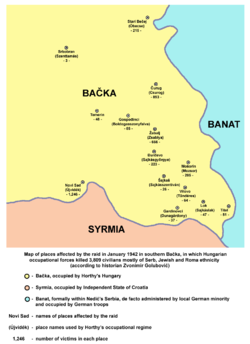
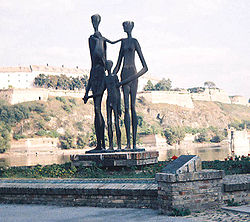

Serbs
The Serbs are a South Slavic ethnic group of the Balkans and southern Central Europe. Serbs are located mainly in Serbia, Montenegro and Bosnia and Herzegovina, and form a sizable minority in Croatia, the Republic of Macedonia and Slovenia. Likewise, Serbs are an officially recognized minority in...
, Jewish
Jews
The Jews , also known as the Jewish people, are a nation and ethnoreligious group originating in the Israelites or Hebrews of the Ancient Near East. The Jewish ethnicity, nationality, and religion are strongly interrelated, as Judaism is the traditional faith of the Jewish nation...
and Roma ethnicity.
Total number of victims
According to historian Dragoljub Živković, approximately 55,000 civilians died in Vojvodina during the Axis occupation. Of those, approximately 17,000 were Jews.According to demographer Slobodan Ćurčić, the total number of the people killed by the occupants between 1941 and 1944 in the entire Vojvodina was 55,285, including:
- 18,193 people who were killed directly
- 19,004 people who were sent to concentration camps and killed there
- 4,168 people who were sent to forced labour and killed there
- 3,286 people who were mobilized and later killed
- 10,634 killed members of the resistance movement
Victims in Bačka
The total number of the killed people in Bačka was 19,573, including:- 6,177 people who were killed directly
- 8,027 people who were sent to concentration camps and killed there
- 2,179 people who were sent to forced labour and killed there
- 1,516 people who were mobilized and later killed
- 1,674 killed members of the resistance movement
Of the total number of the victims (excluding the killed members of the resistance movement), 11,521 were men, 3,768 were women, 1,283 were elderly people, and 1,327 were children.
1942 raid
The most notable war crime during the occupation was the mass murder of the civilians, mostly of SerbSerbs
The Serbs are a South Slavic ethnic group of the Balkans and southern Central Europe. Serbs are located mainly in Serbia, Montenegro and Bosnia and Herzegovina, and form a sizable minority in Croatia, the Republic of Macedonia and Slovenia. Likewise, Serbs are an officially recognized minority in...
and Jewish
Jews
The Jews , also known as the Jewish people, are a nation and ethnoreligious group originating in the Israelites or Hebrews of the Ancient Near East. The Jewish ethnicity, nationality, and religion are strongly interrelated, as Judaism is the traditional faith of the Jewish nation...
ethnicity, performed by the Hungarian Axis troops in January 1942 raid in southern Bačka. Total number of civilians killed in the raid was 3,808, while places that were affected by the raid include Novi Sad
Novi Sad
Novi Sad is the capital of the northern Serbian province of Vojvodina, and the administrative centre of the South Bačka District. The city is located in the southern part of Pannonian Plain on the Danube river....
, Bečej
Becej
Bečej is a town and municipality located in the South Bačka District in Vojvodina, Serbia. The town has a population of 25,703, while Bečej municipality has 40,877 inhabitants. It is multiethnic town, with Hungarians and Serbs as largest ethnic groups...
, Vilovo, Gardinovci
Gardinovci
Gardinovci is a village located in the Titel municipality, in the South Bačka District of Serbia. It is situated in the Autonomous Province of Vojvodina...
, Gospođinci, Đurđevo, Žabalj
Žabalj
Žabalj is a town and municipality in South Bačka District of Vojvodina, Serbia. Žabalj town has a population of 9,582, and Žabalj municipality 27,418. It is located in southeastern part of Bačka, known as Šajkaška.-Name:...
, Lok
Lok, Vojvodina
Lok is a village located in the Titel municipality, in the South Bačka District of Serbia. It is situated in the Autonomous Province of Vojvodina...
, Mošorin
Mošorin
Mošorin is a village in Serbia. It is located in the Titel municipality, South Bačka District. Mošorin is situated in the Autonomous Province of Vojvodina, in the south-eastern part of Bačka, known as Šajkaška. The village has a Serb ethnic majority and its population numbering 2,763 people...
, Srbobran
Srbobran
Srbobran is a town and municipality in South Bačka District of Vojvodina, Serbia. The town is located on the north bank of the Danube-Tisa-Danube channel...
, Temerin
Temerin
Temerin is a town and municipality in South Bačka District of Vojvodina, Serbia...
, Titel
Titel
Titel is a town and municipality in the South Bačka District of the Vojvodina, Serbia. The town of Titel has a population of 5,831, while the population of the municipality of Titel is 16,936...
, Čurug
Curug
Čurug is a village in the municipality of Žabalj, in the South Bačka District of Serbia. It is situated in the Autonomous Province of Vojvodina...
and Šajkaš
Šajkaš
Šajkaš is a village located in the Titel municipality, in the South Bačka District of Serbia. It is situated in the Autonomous Province of Vojvodina. The village has a Serb ethnic majority and its population numbering 4,550 people...
.
1944 deportations of Jews
In March 1944 German units that occupied Horthy's Hungary entered Bačka and Gestapo men were with them. Without any delay the most cruel measures were introduced: the plunder of Jewish property was completed to be absolutely total; Jews had to wear the yellow mark; they were all confined to transit camps before very long to be taken, sometime in June 1944 first to Hungary and then to concentration camps in Austria and Germany. Most of them ended their journey in Auschwitz. Very few of them succeeded to survive and to return. Genocide in Bačka claimed a total of 14,000 Jewish victims. According to available data out of the Jewish victims of genocide 3,800 were from Banat, 11,000 from Serbia and about 260 from Sandžak. Out of about 82,000 members of the Jewish community in Yugoslavia only 15,000 survived World War II which means that 79,2% perished.Victims in Banat
The total number of the killed people in Banat was 7,513, including:- 2,211 people who were killed directly
- 1,294 people who were sent to concentration camps and killed there
- 1,498 people who were sent to forced labour and killed there
- 152 people who were mobilized and later killed
- 2,358 killed members of the resistance movement
Of the total number of the victims (excluding the killed members of the resistance movement), 4,010 were men, 631 were women, 243 were old people, and 271 were children.
Victims in Syrmia
The total number of the killed people in Syrmia was 28,199, including:- 9,805 people who were killed directly
- 9,683 people who were sent to concentration camps and killed there
- 491 people who were sent to forced labour and killed there
- 1,618 people who were mobilized and later killed
- 6,602 killed members of the resistance movement
Of the total number of the victims (excluding the killed members of the resistance movement), 14,484 were men, 3,662 were women, 1,279 were old people, and 2,172 were children.
Liberation struggle
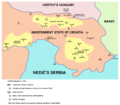

Banat
The Banat is a geographical and historical region in Central Europe currently divided between three countries: the eastern part lies in western Romania , the western part in northeastern Serbia , and a small...
and Bačka
Backa
Bačka is a geographical area within the Pannonian plain bordered by the river Danube to the west and south, and by the river Tisza to the east of which confluence is located near Titel...
was soon defeated, while resistance in Syrmia
Syrmia
Syrmia is a fertile region of the Pannonian Plain in Europe, between the Danube and Sava rivers. It is divided between Serbia in the east and Croatia in the west....
had more success. Syrmian resistance movement was pulped into a mass people's uprising and a large liberated territory (that included about 40 villages) was created in Syrmia. On liberated territory, a partisan
Partisans (Yugoslavia)
The Yugoslav Partisans, or simply the Partisans were a Communist-led World War II anti-fascist resistance movement in Yugoslavia...
authority was organized, which included mass anti-fascist organizations, publishing activity, and education. Experiences of the resistance movement in Syrmia were in summer of 1944 transferred to Banat and Bačka, therefore before Soviet Red Army
Red Army
The Workers' and Peasants' Red Army started out as the Soviet Union's revolutionary communist combat groups during the Russian Civil War of 1918-1922. It grew into the national army of the Soviet Union. By the 1930s the Red Army was among the largest armies in history.The "Red Army" name refers to...
arrived in October 1944, Vojvodina already had its new institutions of people's administration. 15,000 fighters of the resistance movement were killed during the liberation struggle. The liberation movement was organized into 18 Vojvodinian brigades divided into 3 squadrons.
See also
- Greater HungaryGreater Hungary (political concept)Greater Hungary is the informal name of the territory of Hungary before the 1920 Treaty of Trianon. After 1920, between the two World Wars, the official political goal of the Hungary was to restore those borders. After World War II, Hungary abandoned this policy, and today it only remains a...
- Greater CroatiaGreater CroatiaGreater Croatia is a term applied to certain currents within Croatian nationalism. In one sense, it refers to the territorial scope of the Croatian people, emphasising the ethnicity of those Croats living outside Croatia...
- Independent State of CroatiaIndependent State of CroatiaThe Independent State of Croatia was a World War II puppet state of Nazi Germany, established on a part of Axis-occupied Yugoslavia. The NDH was founded on 10 April 1941, after the invasion of Yugoslavia by the Axis powers. All of Bosnia and Herzegovina was annexed to NDH, together with some parts...
- Banat (1941–1944)
- 1944-1945 killings in Vojvodina
External links
- Carl Savich: Genocide in Vojvodina and Greater Hungary, 1941-1944.
- Hungarian Is Faced With Evidence of Role in ’42 Atrocity
- Chronology of the development of fascism and the anti-fascist struggle of the peoples of Yugoslavia 1941-1945
- Krv je tekla Novim Sadom (in Serbian)
- Map - occupation zones in Vojvodina
- Map - occupation zones in Vojvodina
- Map - liberated and semi-liberated territories in Vojvodina

